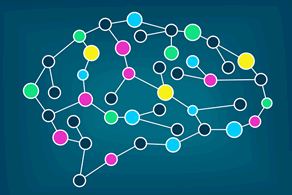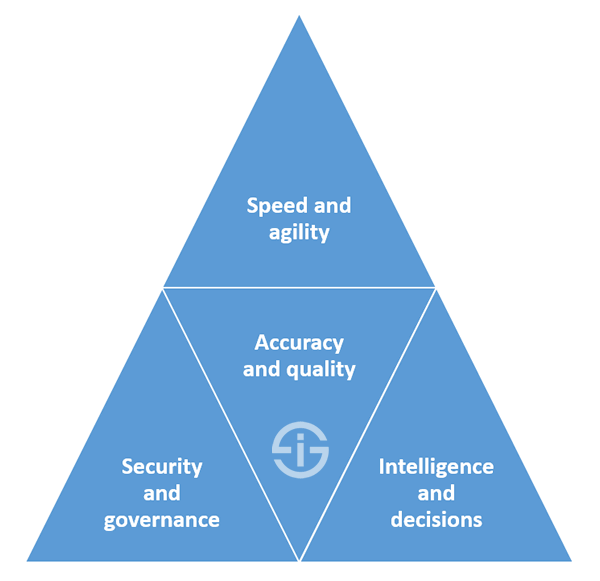 One of the success pillars in any digital transformation project or enterprise-wide change challenge for today’s and tomorrow customer/stakeholder and business success is the capability regarding information management.
One of the success pillars in any digital transformation project or enterprise-wide change challenge for today’s and tomorrow customer/stakeholder and business success is the capability regarding information management.
The term ‘information management’ is used with caution here as it’s not just about managing information in the sense of ‘maintenance’. While systems of records are key as they form the backbone of information and data activation, systems of engagement and the last mile of the information process are critical.
That last mile could be in relationship with the customer experience, the end of an information-driven value chain or, increasingly, the point of automated (inter)action where specific information sets in motion an entirely automated connected process.
The latter is, for instance, what you will typically see in an Internet of Things (IoT) context. Traditionally, information management went from information capture, digitization, storage, retrieval, governance and process optimization to the actual output or use of information in any form, process, system or connection with other systems.
Intelligent information activation: why and what
A few years ago we were talking with a customer about the future of information management. One of the topics we wanted to emphasize was the ongoing evolution towards systems of engagement and the actual use of data instead of the focus of the sheer volume and variety of ever more unstructured information and data.
We felt that intelligent information activation seemed like the term to use as it’s not how we manage information (alone) that matters (the ‘intelligent’ part has a lot to do with customer experience as John Mancini explained in a presentation and during the several interviews we had but also about something else ‘intelligent’ as you will read below) .
It’s also not about data as such but about how that data is used to serve any possible purpose. Actionable data, smart data, you know the terms. Traditionally such goals served with information include servicing customers better with the right data at the right time and in the right context. Or triggering, feeding, automation and improving processes.
However, as the ecosystem of information and data – and how it becomes part of ever more complex and broader ecosystems – increasingly automates the data and content exchange as such (think IoT again), we move towards an economy of APIs, smart information agents (not human) and information connectors, fed by and feeding information-related activities, and at the very center of any digital transformation strategy.
Understanding the role of information in digital transformation: the evolution of the Web
An easy way to make it more tangible is to consider the so-called 3 stages of the Web:
Web 1.0 was about connecting information
It was the Web of hyperlinks (hypertext) and underlying Internet/Web protocols and technologies. People consulted information and only some added it.
The impact was huge and the focus was on management of information in the strict sense but also in the sense of enabling people to get access to it in the most user-friendly ways that were available back then.
Search, for instance, in all possible applications (the Web, content management systems, intranets etc. was – and still is – of the utmost importance, also for the digital customer experience).
Web 2.0 added an interactive element
It did so through the use of a range of technologies which in turn also added the human element. People consulted, added and exchanged information, essentially what social media, social technologies and social business are all about.
They could now use more ways to ‘get’ information and create it while organizations could optimize digital experiences, improve processes and engage by making the right information available in the right format at scale and increasingly individually, depending on the context of the user. It was and is a highly contextual given in other words whereby engagement, the connection of systems, leveraging data and the individual needs and preferences of people took center stage with the focus on ubiquitous and contextual availability and on experiences as new channels and devices popped up.
Web 3.0, the device and intelligent meaning
Web 3.0, usually seen as the – semantic – Web of everything, the Internet of Things and ‘meaning’ adds not just more data as already was the case in 2.0 but it also adds the element of the ‘connected device’.
And devices, nor the systems and data/information flows and processes that connect them don’t interact and exchange information as people do.
It’s in the addition of ‘things’ and ‘contextual meaning’ where semantics come in the picture and that the bright future for software developers and importance of code should be seen.
Adding intelligence to information context and outcome
It’s also in this hyper-connected and hyper-contextual context that the so-called API economy should be seen. Last but not least, it’s in this regard that a large part of cognitive computing, artificial intelligence and as Gartner calls it the algorithm economy needs to be understood (meaning, mining, automating, understanding and predicting).
Because connecting systems (almost always needed in all digital transformation projects) means connecting information. That takes more than just adding some quick features, it’s an often difficult task in a complex ecosystem of diverse formats, multiple standards, increasing volumes, legacy systems and now the addition of ever more elements – including devices – to the Web, the Internet and the data picture of each organization, process and the digital data space as such.
When we talk semantics and meaning from data (the Internet of Things is really about automation of processes and data) , we talk artificial intelligence. It’s also why we decided to speak about INTELLIGENT information activation, instead of about information management, let alone intelligent information management.
Obviously intelligent information activation encompasses many steps and aspects but it’s clear that digital transformation and information activation go hand in hand. It’s not a coincidence that before we talked about digital transformation in its current meaning, digital transformation was used in a context of digitization: the transformation of information as such, from physical to digital to process.
Attributes of a smart information activation approach for digital transformation
An intelligent information and data activation capability is key in digital transformation success in several ways and requires attention from multiple angles.
Here are a few intelligent information activation core capacities you need to have:
Speed and agility – from differentiation and innovation to optimization
Speed has become a de facto differentiating and even competitive factor. The speed at which you’re able to connect input of information to process to outcome is as essential as the speed of innovation capability, optimization capacity, responsiveness and much more.
It’s the velocity aspect of fast data that is needed in a real-time economy. Slow processes and information flows mean unsatisfied customers. Note that, despite all the automation and so on, agility and speed are not just about systems. They are also a matter of human decisions, for instance in regards to where to speed up what for which reasons. Even if this becomes automated too, you still need human creativity, intelligence and innovation skills to come up with differentiating ideas, just as you need people to develop and connect what is needed.
Security and governance – the business value and personal human value of data
We’ll mainly look at security as it can’t be emphasized enough. Just as business, customer service, customer experience ‘management’ etc. need a holistic approach, information management and security need that holistic take too (and optimization as you can read here).
Data and information are key business assets (the ownership debate is another thing) and form the backbone of this digital economy. Just as customer-centric leaders see customers, employees and stakeholders as essential ‘assets’ (which doesn’t mean dehumanizing them, well on the contrary), CxOs look at data/information and the ‘protection’ of it as key business assets and a corporate responsibility, making security de facto enter the boardroom. It’s again a very human decision and obviously covers more than business value. The ethics of data and privacy do matter and will increasingly matter during a period where we’ll face a backlash as we predicted and as we can clearly see today in many areas, from dealing with data for advertising to regulations.
Accuracy and quality – facing consequences of mistakes
It’s a well-known fact that garbage in means garbage out. Even if this term became popular in the sixties in a context of information systems, ‘garbage in, garbage out’ or GIGO matters a lot.
It’s easy to see how bad data and information quality, starting from the source (feedback, data capture, digitization, pipelines,…), through the process and all the way to the outcomes is deadly, in some situations – think healthcare– even literally deadly.
Errors, costs, loss of productivity and all the consequences they come with. In other words: making sure you replace underperforming and error-prone elements such as manual data entry, getting the methods/goals/strategies of data gathering and of processing right and avoiding too much steps between information source and process is key (the more steps, the more potential errors, certainly when involving physical actions, just think transportation of documents or how we lose meaning and understanding with each step of passing on narrated feedback). Note that you will need people here too in many aspects of the accuracy and quality picture. Guardians of not just productivity but also of human value and errors with potentially far-reaching consequences.
Intelligence and decisions – the last mile where people matter and care most
Analytics, such as content analytics or deriving meaning from text and turning data into intelligence into decisions are the core success factors in the last mile we mentioned whereby that last mile ultimately matters most.
Whether it’s the last mile of customer experience (the last impression matters most) or the last mile in a broader context of disruption regarding value, CX and other chains as SAP’s Sameer Patel explains very well where he talks about how true disruption is about putting the last mile first (and which inspired us to embrace that last mile ‘image’, we embedded a presentation by Sameer below): it can’t be emphasized enough.
Although here as well automation and technology (artificial intelligence) become paramount, also in decision-making, it’s clear that the creative and innovative, deeply human and emotional, dimension of looking behind the why of intelligence and coming up with the imagination to turn it into brave ideas and innovative ways of doing business and taking decisions where machines cannot, remains essential here too.
Predictive analytics are one thing, human decisions and – indeed – common sense, gut feeling and (inter) acting are another. The last mile of experience and of intelligent information are not just what people care about most but also where people matter most.

Digital transformation and information management: facts and next steps after activation
Intelligent information activation is one aspect of the overall role of information management in digital transformation success. However, it’s not the only one.
In the meantime here are some forecasts from IDC for 2016 and beyond, illustrating some of the topics we just explained:
- In 2016, 65% of large organizations will have committed to become information-based ones. Knowing that customer experience, stakeholder efficiency/value/experience and digital transformation are what the next few years will be all about according to IDC, Gartner, Forrester and really everyone you talk with, it’s clear that information-based is simply a given in a digital knowledge economy.
-

The customer as an asset – Jeanne Bliss The organizational focus will shift towards intangible capital. Remember what we said about the customer as an asset, which is very well explained by customer experience expert Jeanne Bliss, for instance. And of course also information as intelligent capital on top of people and relationships which are both mentioned as intangible capital too by IDC (yes, people and relationships).
- By 2020, it is expected, 60% of the G2000 will have doubled productivity by digitally transforming many processes from human-based to software-based delivery. The latter, ongoing automation and removing human tasks where needed, along with the fears of AI and the next stages of digital transformation obviously lead to the concerns regarding employment as they are increasingly voiced. It is safe to say, as mentioned, that human innovation, creativity, emotions (what else is customer experience about?), decision-making (think complex tasks and exceptions or morally important decisions) and ‘intelligence will be needed for many years to come, as is the need for developers, strategists, creatives, innovators, quality controllers and so on. At the same time it’s also safe to say that there will be challenges which need to be addressed too.
Beyond digital transformation: from holistic optimization to the optimization of the living ecosystem
Technology is never the final answer nor the essence. It’s what it can do which continues to matter. All the rest is human. And that’s also what intelligent information activation is and should be about: smarter, better, more valuable and even life-saving outcomes for people.
Indeed, holistic and hyper-connected optimization, as far as we’re concerned the goal of information but also of technology, disruption and digital transformation as such. Holistic optimization with less focus on the technology dimensions as it exists now and more on the human/emotional aspects are what’s coming AFTER digital transformation.
Come to think of it: some see Web 4.0 as the Web of emotions. But that is an entirely different story.

